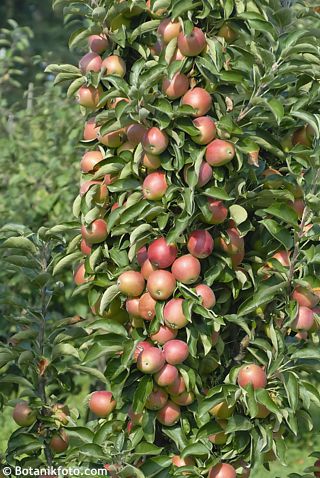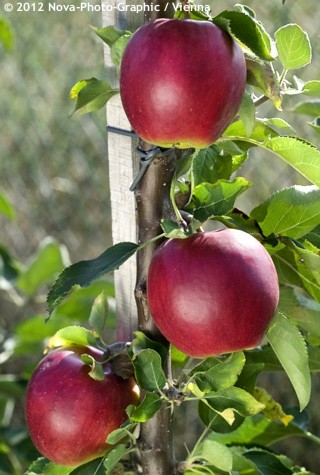Malus domestica 'ARBAT' columnar apple - medium late
size/type
small tree,small tree
usual height
2-3m
usual width
0,4-0,5m
leaves
deciduous broadleaf
flowers
showy
blooming time
April-May
location
full sun
soil type
any (acidic to alkaline)
soil moisture requirements
evenly moist but well-drained
USDA zone (lowest)
5 (down to -29°C)
winter protection
for zone 5+6

for zone 7

categorized
Description of the plant:
Arbat is a columnar apple variety producing mid-sized, rounded, slightly flattened fruit. Its skin is half yellow-green and half soft red. The flesh is pale yellow, firm, crispy, aromatic, very juicy, with well-balanced sweetness and tartness. Harvest is possible from late September and apples can be stored until January or February under ideal conditions. As most other columnar apples Arbat, too, is highly resistant to common apple tree diseases. Being self-sterile it needs another pollinator for heavy crop, such as Čistecké, Discovery, Fuji, Gala, Golden Reinette, Granny Smith, James Grieve, Jonathan, Melrose, Opal, Otava, Pinova, Red Delicious, Rubinola, Rubín, Santana, Spartan, Starking nebo Topaz. Bear in mind that columnar apple trees are a choice for small gardens where you cannot accommodate a standard apple tree. Their yield is low, commonly suited for one family consumption eaten right off the tree without a need to collect apples for storing.
Apple trees will grow in almost any well-drained soil but for best results provide them with deep, fertile soil and keep it moist at least 6 months after transplanting and in early summer when fruit is formed. Pruning can be done in frost-free periods of winter but columnar apple varieties make only short lateral spurs which don’t require pruning or trimming. Still, it may happen than one odd branch goes mad and forgets to be columnar. Remove such at any time during the year. Other pruning can be done in the middle of winter or in early spring before the buds begin to swell. Hardy to min. -30 °C (USDA zone 5).
Last update: 24-10-2022
QUICK PRICE OVERVIEW
CURRENTLY SOLD OUT
WANT TO TRY A SIMILAR PLANT?

















